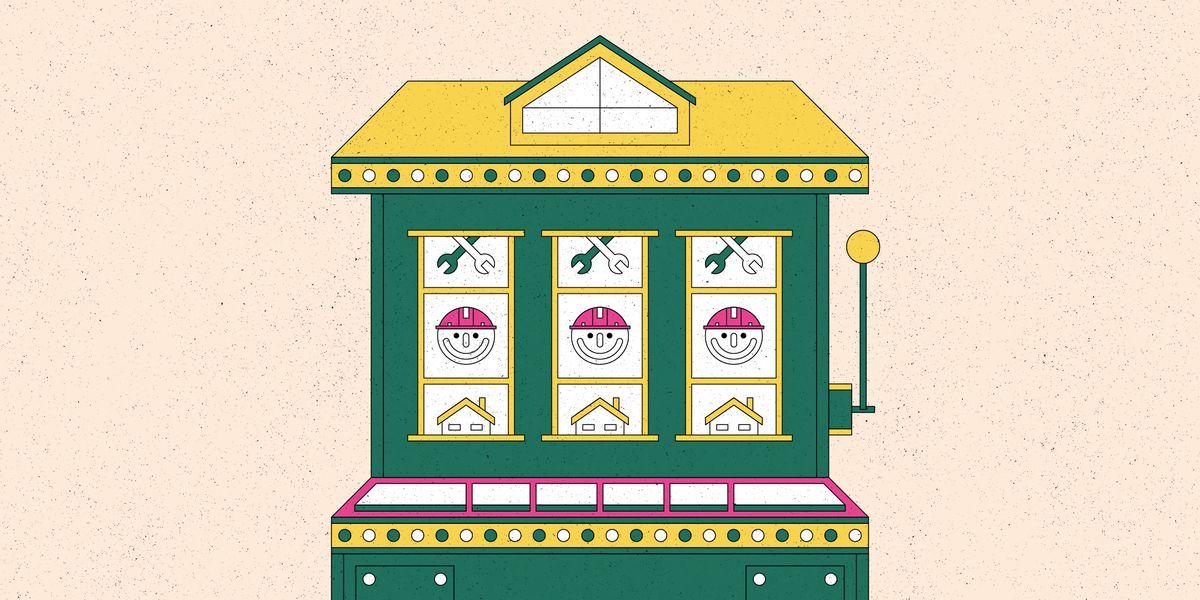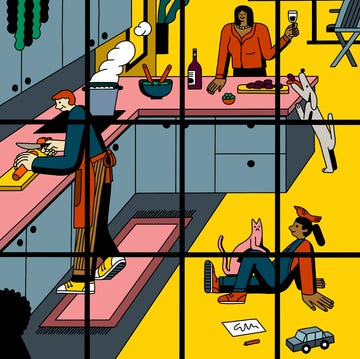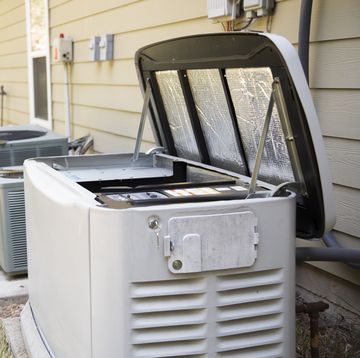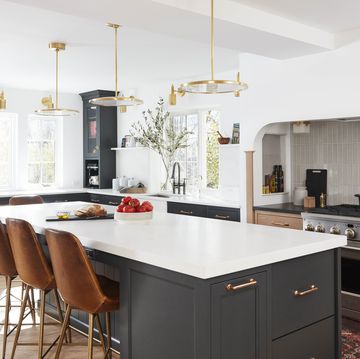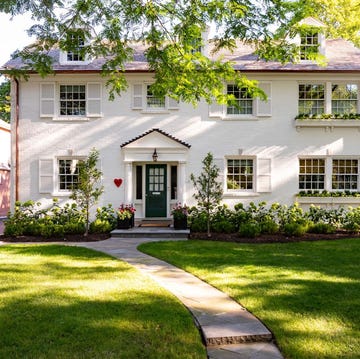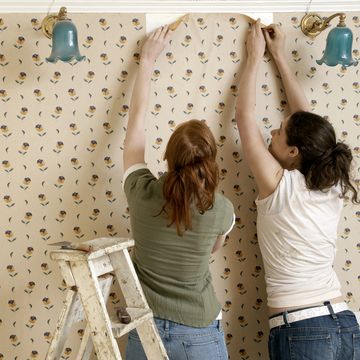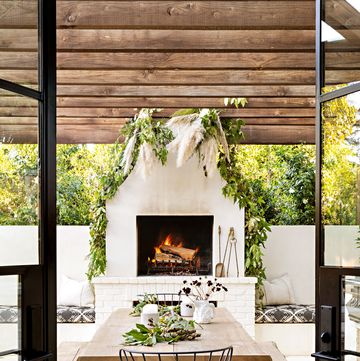Already stressful, home improvement projects now come with a host of new headaches, from longer wait times to higher costs. Kaitlin Petersen, editor-in-chief of trusted industry expert Business of Home, reveals how to navigate the ineviable questions you'll face. Here's what you need to know before you gamble on a renovation.
What If It Gets Terribly Delayed?
At this point, having patience throughout the renovation process is simply table stakes. Construction projects of all shapes and sizes are taking longer these days—15 to 30 percent longer than in 2016, says Arizona contractor Brad Leavitt, president and founder of A Finer Touch Construction in Scottsdale. And while the bogged-down supply chain gets plenty of the blame, there are delays at every step. Take permits: Leavitt has found that what was once an eight-week process can now take 16 (or even 30) weeks as local municipalities struggle to keep up with a surge in demand. All the while, the project just sits, a frustrating scenario for the design team and the homeowner. Other delays—like a project that’s at a standstill until that back-ordered tile arrives—are even harder to predict, but just as common.
Might I Blow the Budget?
Prices for single-family renovations are up 26.1 percent on average, according to the National Association of Home Builders. The increased costs of labor and raw materials, coupled with a shortage of housing stock and overall demand, are driving numbers higher. But there’s some good news too: While interest rates are starting to creep back up, they’re still historically low—and a smart renovation can add enough value to your home to justify the expense. “What we’re seeing in the mortgage industry is that a lot of people are saying, ‘I’ve got all this equity in my home, and my house value is the highest it’s ever been—maybe I can tap into that to do the things I’ve been dying to do,’ ” says Jess Kennedy, cofounder and COO of direct-to-consumer mortgage lender Beeline. “Coupling [low interest rates] with high home values, it feels like cheap money.”
What If There's a Labor Shortage?
Designers, architects, and builders across the country say their phones have been ringing off the hook. With their services in such high demand, many are booking projects with start dates months in advance. And once you’ve secured your team and a start date, their tradespeople will be asking them to wait too. “One of the issues we’re dealing with now is a shortage of workers. Our vendors and tradespeople are struggling to keep good employees,” says Minnesota designer Amy Leferink, owner of Interior Impressions. On one recent project, the drywall tapers walked off the job and the plumber got sick—just two of the many challenges that pushed the timeline three months longer than expected. “Even in the best situations, we’re still challenged by availability,” she says. “People are so overloaded and busy that they can’t keep up.”
Will I Regret Everything?
The current building boom may be a pandemic-inspired craze, but many of the life changes people are designing around are here to stay. “I don’t think that there will ever be a regret about adding functionality and flexibility to your home,” says Leferink. “Even if everyone’s back to work and back to school, we have been forever changed in the way we use more of our homes.” What you might regret most is not going for it: Some economists project that housing and building prices will continue to trend upward for the next three to four years, which means you’ll save more by starting now unless you’re willing to wait a long, long time. “It’s not great right now, but it’s still manageable,” says Leferink. “It’s going to get worse before it gets better, so I don’t think it’s worth waiting if it’s something you want to do in the next five years.”
Ensure You Get Your Money Back
The housing market is hot right now, so at least in the short term, investing there is a safe bet. Some homeowners are even getting an enthusiastic thumbs-up from their mortgage lenders with plans to transform their fixer-uppers that dramatically boost the home’s value. How much you spent on your home in the first place, where you’re putting your money now and how long you plan to wait before you sell all impact the type of ROI you can expect from your renovation. But generally speaking, designers say clients fall into one of two camps:
Planning for Resale
Just because you aren’t in your forever home yet doesn’t mean your selections have to be boring. If you are worried about resale value, a designer can point you towards the surfaces and appliances that their new-build clients have been specifying to keep you squarely in line with what’s trending. “We can say, ‘Everyone wants quartz countertops right now, not granite,’ and encourage them to lean in that direction to help with sellability,” says Leferink.
Customizing a Forever Home
The sense of ease that comes from a truly customized home that transcends dollars and cents—the delight a left-handed client feels upon discovering that their electric toothbrush plugs in on the left side of the sink, or that the laundry machine is along the route from where they work out to the shower so that dirty clothes never pile up. When designing a lasting landing pad for your family, designers want to know everything, from when you wake up and where you want to drink your coffee in the morning to how you cook, how you feel about clutter and whether you’d benefit more from a closet or coat hooks. This isn’t about cookie-cutter style, what’s trendy, or appealing to the next buyer—it’s about spending big on the design elements that will support a better life. If that’s not a return on investment, what is?
How to Hold the Winning Hand
Here’s how to play your cards so you come out on top.
Save Wisely
Some costs will be out of your control. “You need wood in your house, so you can’t necessarily say, ‘I’ll wait until the market cools off’ for that,” says Pittsburgh designer Colleen Simonds, who recommends choosing less-expensive materials for lightly trafficked spaces, like guest bathrooms or even a kid’s bedroom. There are plenty of elegant middle-of-the-road lighting and hardware options that don’t sacrifice quality.
Hire Pros
Ask prospective contractors and designers how they’ve adapted to pandemic delays. Some have reorganized so that clients are selecting the hardest-to-get items first—especially plumbing fixtures, appliances, and upholstery. “We used to have the luxury of time,” says designer Judy Pickett of Design Lines Signature in Raleigh, North Carolina. “[Now] we’re rolling furnishings into the early phases so that we have product to install at the end.”
Install in Phases
The “big reveal” after an installation can be a magical experience. But bringing pieces into the home as they arrive can save you thousands in shipping and warehousing costs over the life cycle of a project. Just one word to the wise: If you go this route, remember that the space might not look right until everything is installed. (Your designer didn’t want you to see the half-finished house for a reason!)
Be Decisive
Take the entire selection process seriously and be thoughtful, but don’t second-guess your choices. In this environment, changing your mind can be the ultimate setback, delaying a project for months: “It’s like waiting two hours at Disneyland and then stepping out of line to go to the bathroom,” says Connecticut-based designer Georgia Zikas. “Don’t do it!”
And If All Else Fails... Let the Chips Fall
One of the best tips for making it through a renovation in today’s climate? Make peace with what is out of your control, and be proactive about the rest. “We can protect the client from incidental delays and higher costs 85 percent of the time, but 15 percent of the time we can’t,” says Leavitt.
Start on the right foot by not rushing through the predesign phase. Leferink recommends eight weeks of planning time prior to the start of construction. “A lot of remodelers we work with are moving to a plan where they order all of the materials in advance and do not start the project until they have everything. That way, they can keep to a pretty normal schedule [once construction begins], so there aren’t as many delays.”
Make no mistake: Some issues will arise during construction. But a builder with long-standing relationships can draw on them when the going gets tough. “The ideal situation is a builder with loyal crews and regular tradespeople who are going to give them some priority,” she says. “If I were remodeling my home right now, I would want to know what their track record is for completing a project on time, and what their vendor relationships are like.” With your vision locked and a dream team in place, you can rest easy.
Kaitlin is the editor in chief of Business of Home and the host of the podcast Trade Tales. She has been writing about style and design for more than a decade, and her work has appeared in Elle Decor, House Beautiful, Metropolitan Home and Veranda, as well as Chicago, Texas Monthly, Time Out New York, and the international editions of Vanity Fair and Vogue. In her free time, she kayaks on the Hudson River, gardens on her Brooklyn terrace, and scours Zillow for 1800s farmhouses to decorate in her head.
